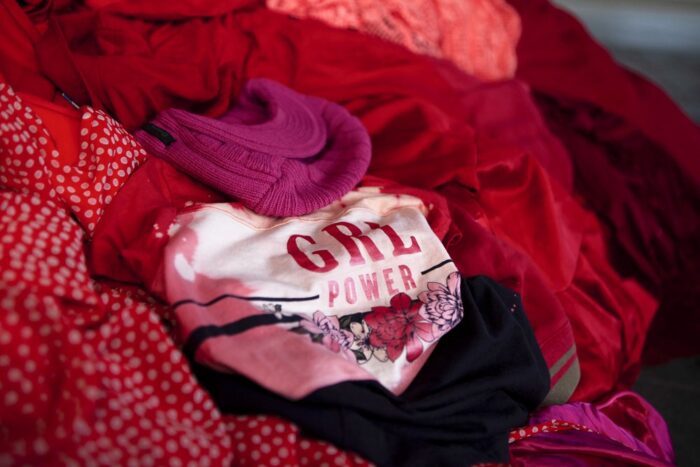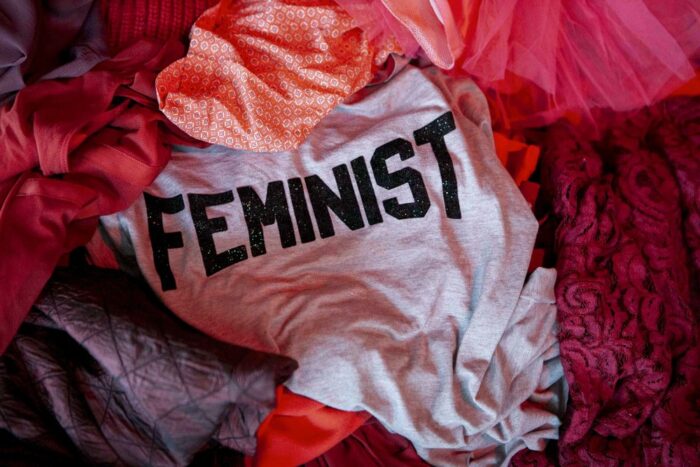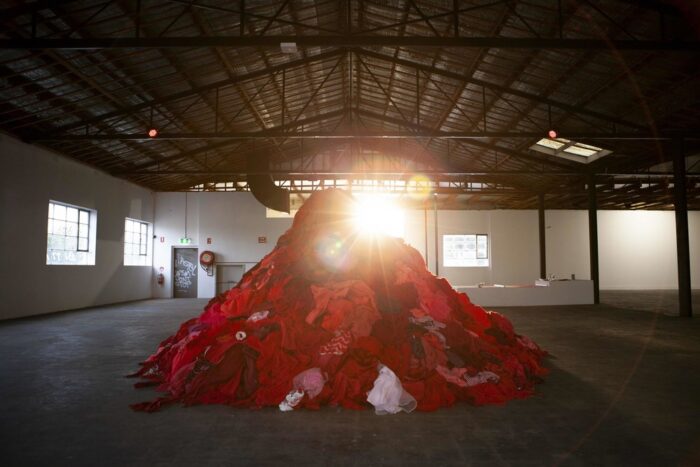Blood Mountain – an art installation by Suzie Blake artist
By Suzie Blake
It was just after Christmas and I was wandering around the basement of a well-known Melbourne department store. I had some time to kill before my meeting with an art gallery director. He was to show me a new space he had discovered, one that I would soon be exhibiting in.
It was hot outside. Inside however, I was cooled by the temperature perfect air-con. Surrounding me was a swamp of women’s clothing. Audacious red sale signs roared at me, flagrantly enticing me with their many per-cent-off iterations. Rack after rack. Pile after pile. I was in a quagmire of textiles — and it was unending. Laser focussed ladies were penning through rails that looked like overfilled salad sandwiches. Then something caught my eye. I noticed one lonely T-shirt with “Girl Power” emblazoned on the front. I stopped and took a photo. This deserted T made me think, is this “girl power” — all this, ummm … clothing?

I visited the gallery space, a once-was garment factory, and knew immediately what the exhibition would be about.
I started to research the fashion industry. I’d heard the stories; you know the ones, about those horrible sweatshops. But what I learned over the coming months made the sweatshop stories seem like a sneeze in a hurricane. I came to realise that my prior knowledge was embarrassingly naïve. I had no idea about the astronomical disaster machine that is: fast fashion.
Here are some un-fun facts. The fast fashion industry is the second biggest polluter after oil. Most garment workers are women, or sometimes girls — around 85%, who get paid on average $3 a day. They have very few rights; abuse isn’t uncommon. Many of these women are forced to leave their homes (and their children) for months, sometimes years, to slog it out in conditions we, in the West, would find incomparable. As for the environmental impact, well it isn’t just landfill that’s the problem. Fast fashion’s ecological disaster trail starts from the moment a cottonseed is planted in a Monsanto monopolized farm.
I could go on, but you’d probably be better off watching the utterly fantastic documentary film “The True Cost” or reading the work of Lucy Siegle, or listening to this Ted Talk by Clara Vuletich. There is a plethora of information online, if you’re willing to swallow the red pill.
The thing is, I’m not an expert on fast fashion. I’m an artist. I’m also a feminist. And I tend to make artwork about females.

What I learned during the development of my new art exhibition is that fast fashion is an issue for women and an issue for feminists. But a lot of feminists appear to be ignoring this issue like the Catholic Church ignores its paedophile problem.
Why do I think this? Because, among other things, self-proclaimed feminists are proudly wearing t-shirts asserting a pro-women stance made by garment workers who get paid per day what you or I earn every 5 minutes (or for some of you, per second). The fact is, proclaiming “I’m a Feminist” via a T-shirt made by a woman who is anything but empowered is, aside from hypocritical, possibly one of the most brazen examples of Western capitalist arrogance imaginable. Achieving the right to vote and equal pay took hard work and determination, and those things certainly weren’t won by wearing a $3 T-shirt that says “Girl Power”. When Bikini Kill used the slogan it had merit, but that surely died when the Spice Girls co-opted it.
Some may argue that it’s arrogant of Western nations to go into developing countries and tell them how to operate, and I agree. But this isn’t about telling other countries what to do. It’s about saying, “I want my clothes to be made by people who are treated humanely and with dignity”.
Some brands are taking note, but let’s not be hoodwinked by the smoke and mirrors of ethical capsule lines within the broader business model (although it’s a start). Ecologically sound manufacturing and ethical treatment of staff should come as standard, not optional. It’s no good having a few organic cotton T-shirts that can only be afforded by environmentally minded hipsters prone to proclaiming wokeness.
Like it or not, we live in a globalised world. And with the advent of technology we’re only going to get closer to one another. The women making our clothes are our sisters, and they deserve better from us. Feminists in countries like my home country of Australia, or the US and Europe are lucky. Lucky to be born in places, however imperfect, that have laws, which protect us from being abused, and ensure we are paid properly for our labour.
This isn’t meant to be an attack on feminism. The betterment of our lives is due to the strides made by the Women’s Liberation movement. But we should always aim to do better. Our movement is not just for us. Us, in our nice little homes with our neat roads and public libraries. With our clean hospitals and sporting facilities. With our free schools and glittering shopping malls. Our delightfully clean water and council managed garbage collections. Women’s Liberation developed out of the need to liberate women. All women.
So what, you may be wondering, did I create in order to express all this?
I created “Blood Mountain”.
And what exactly is “Blood Mountain”?
It’s a sculptural installation featuring a 3-meter high mound of red clothing and apparel, kindly donated by the amazing people at Savers.

In the 3000-kilogram pile are T-shirts with slogans like “Girl Power” and “The Future Is Female” which peak out from crimson red dresses and nylon stockings. Fashion items, once hung in pristine department stores now displayed like a giant pile of landfill. “Feminist” T’s embedded in coats, skirts, bras, tutus and dressing gowns; all in the hue of that liquid which runs through our veins and tarnishes our hands when we remain silent on serious issues.
Why a mountain? Mountain is considered the archetype of ascent and power — the bridge between heaven and earth. The idea was to reimagine this archetype in the form of greed and waste.
“Blood Mountain” asks, what is the environmental cost of bloated man-made structures? And what is the role of feminism within such structures? Also, whose empowerment does the current iteration of the feminist movement serve? And since when did we think it was acceptable for brands to piggyback on our movement?
But another thing we really need to ask ourselves is this. Is it possible, for we women — the biggest consumers of fast fashion — to buy a little less stuff?
Blood Mountain is on show at Grau Projekt, in Melbourne, Australia until 1st June 2019.
In conjunction with Fashion Revolution Week Suzie Blake will be holding a very special artist talk on Saturday 27th April at 12pm.
This is a free event but it is advised you sign up to the guest list, as spots are limited.





